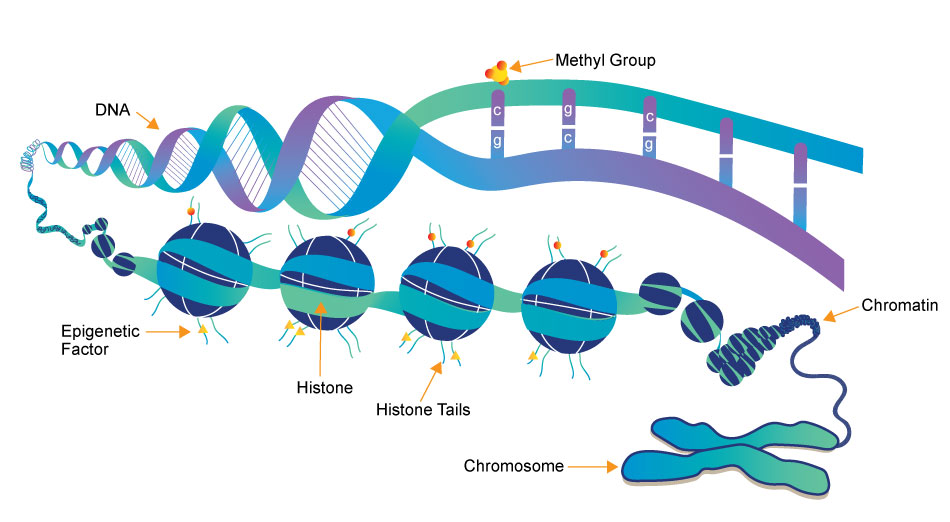Epigenetics - Tyk2


Epigenetics research delves into the molecular mechanisms that control gene expression and cellular traits without altering the underlying DNA sequence. One crucial aspect of this field is the role of small molecules, which act as powerful regulators of epigenetic modifications. These small compounds, typically comprising a few dozen to a few hundred atoms, have emerged as essential tools in understanding and manipulating the epigenome.
- DNA Methylation Inhibitors: Small molecules like 5-azacytidine and 5-aza-2'-deoxycytidine are DNA methyltransferase inhibitors. They block the addition of methyl groups to DNA, leading to DNA demethylation. This can reactivate silenced genes, potentially offering therapeutic avenues for conditions like cancer.
- HDAC inhibitors: HDACs remove acetyl groups from histone proteins, contributing to gene repression. Small molecule HDAC inhibitors, such as Vorinostat and Romidepsin, can reverse this process by increasing histone acetylation, allowing genes to be more accessible for transcription. These inhibitors are being explored for cancer therapy and other conditions.
- Histone Methyltransferase Inhibitors: Small molecules like GSK126 inhibit specific histone methyltransferases, affecting histone methylation patterns. This can alter gene expression, making them promising candidates for cancer and other diseases with epigenetic dysregulation.
- RNA Modulators: Small molecules can also target non-coding RNAs involved in epigenetic regulation. For instance, small molecules called small interfering RNAs (siRNAs) can be designed to target and degrade specific long non-coding RNAs, influencing gene expression.
- Epigenetic Reader Domain Inhibitors: These small molecules target proteins that recognize and bind to specific epigenetic marks. Examples include inhibitors of bromodomain-containing proteins (BET inhibitors), which can disrupt gene regulation by interfering with protein-DNA interactions.
Small molecules in epigenetics research not only provide insights into the fundamental biology of gene regulation but also hold immense promise for developing novel therapeutics. Their ability to selectively modulate specific epigenetic marks and pathways has led to ongoing clinical trials and drug development efforts for various diseases, including cancer, neurological disorders, and inflammatory conditions. Understanding and harnessing the power of these small molecules is at the forefront of modern epigenetics research, offering new hope for precision medicine and targeted therapies.
3 key components involved in the regulation of epigenetic modifications
Epigenetics Writer
Epigenetics writers are enzymes responsible for adding chemical marks or modifications to DNA or histone proteins. These marks include DNA methylation (addition of methyl groups to DNA) and histone modifications (such as acetylation, methylation, phosphorylation, etc.).
Epigenetics Reader
Function: Epigenetics readers are proteins that can recognize and bind to specific epigenetic marks on DNA or histones. These reader proteins interpret the epigenetic code and facilitate downstream cellular processes, such as gene activation or repression.
Epigenetics Eraser
Function: Epigenetics erasers are enzymes responsible for removing or reversing epigenetic marks on DNA or histones. This process allows for the dynamic regulation of gene expression and the resetting of epigenetic states during various stages of development and in response to environmental changes.
-
JAK 抑制剂
LY2784544 被确认为对 JAK2-V617F 具有高度选择性,并已进入人类临床试验阶段,用于治疗多种骨髓增生性疾病。 -
JAK1/2 抑制剂
INCB018424 是一种强效且选择性的 Janus-associated kinase (JAK) 1 和 2 抑制剂,其半抑制浓度(IC50)分别为 JAK1 2.7 nM、JAK2 4.5 nM 和 JAK3 332 nM。- Meenu Kesarwani, .et al. , Blood Adv, 2024, Jun 11;8(11):2765-2776 PMID: 38531054
- Aya Hasan Alshammari, .et al. , Biochem Pharmacol, 2022, Mar;197:114914 PMID: 35041812
- Daniel Doheny, .et al. , Oncogene, 2020, Oct;39(42):6589-6605 PMID: 32929154
- Rasmus Siersbek, .et al. , Cancer cell, 2020, Jul 6;S1535-6108(20)30311-1 PMID: 32679107
- Brittany M. Duggan, .et al. , Sci Rep, 2017, 7: 1578 PMID: 28484277
- Fujita KI, .et al. , J Pharm Sci, 2017, Sep;106(9):2632-2641 PMID: 28479358
- Kagoya Y, .et al. , Blood., 2014, Nov 6;124(19):2996-3006 PMID: 25217696
-
JAK 抑制剂
Baricitinib,也被称为INCB028050或LY3009104,是一种选择性的口服生物利用度的JAK1/JAK2抑制剂,对JAK1(5.9 nM)和JAK2(5.7 nM)具有纳摩尔级的效力。- Hongli Liu, .et al. , Adv Rheumatol, 2023, Aug 28;63(1):45 PMID: 37641106
- Dandan Wang, .et al. , Adv Rheumatol, 2023, May 16;63(1):22 PMID: 37194022
- Yuki Sasaki, .et al. , JCI Insight, 2022, Apr 8;7(7) PMID: 35393946
- Yutian Lei, .et al. , Kidney Int, 2021, Feb 16 PMID: 33607177
-
JAK1/2 抑制剂
Ruxolitinib sulfate(INCB018424 sulfate)是首个进入临床的强效、选择性 JAK1/2 抑制剂,其 IC50 值分别为 3.3 nM/2.8 nM,并且对 JAK1/2 比 JAK3 的选择性高出 130 倍以上。 -
JAK 抑制剂
磷酸鲁索替尼是鲁索替尼的磷酸盐形式,这是一种口服生物可用的Janus相关激酶(JAK)抑制剂,具有潜在的抗肿瘤和免疫调节活性。 -
pan-JAK 抑制剂
PF-06263276(PF 6263276)是一种强效且选择性的全面JAK抑制剂,其IC50分别为JAK1的2.2 nM、JAK2的23.1 nM、JAK3的59.9 nM和TYK2的29.7 nM。 -
JAK2/FLT3 抑制剂
Pacritinib,也被称为 SB1518,是一种口服生物可利用的 Janus kinase 2 (JAK2) 和 JAK2 突变体 JAK2V617F 的抑制剂,具有潜在的抗肿瘤活性。Pacritinib 与 JAK2 竞争 ATP 结合,这可能导致抑制 JAK2 激活,抑制 JAK-STAT 信号通路,从而引发依赖半胱天冬酶的凋亡。- Angelina T Regua, .et al. , Cancer Lett, 2024, Jun 7:597:217023 PMID: 38852701
- Daniel Doheny, .et al. , Oncogene, 2020, Oct;39(42):6589-6605 PMID: 32929154
-
JAK1 抑制剂
PF-03394197(奥克拉西替尼)是一种强效的JAK1抑制剂。- Steven E. Davison, .et al. , PLoS One, 2022, Oct 18;17(10):e0276333 PMID: 36256616
- Banovic F, .et al. , Vet Dermatol, 2018, Nov 12 PMID: 30417482
- Nicholas B, .et al. , J Allergy Clin Immunol, 2017, Jul;140(1):309-312.e4 PMID: 28259448
- Fukuyama T, .et al. , J Pharmacol Exp Ther., 2015, Sep;354(3):394-405 PMID: 26159873
-
JAK1 抑制剂
GLPG0634 是一种口服可用的、选择性的 JAK1 (Janus kinase 1) 抑制剂,由 Galapagos 公司开发,用于治疗类风湿性关节炎以及可能的其他炎症性疾病。- Keisuke Nishimura, .et al. , Arthritis Rheumatol., 2015, Apr;67(4):893-902 PMID: 25545152
-
JAK 抑制剂
JAK Inhibitor I 是一种强效的、可逆的、细胞渗透性的、与ATP竞争的 JAK1、JAK2 和 JAK3 抑制剂。- Ya-Ge Zhang, .et al. , J Neuroinflammation, 2023, Sep 27;20(1):216 PMID: 37752509
-
Dual Syk and JAK 抑制剂
PRT062070 是一种新型口服双重脾脏酪氨酸激酶(Syk)和 janus kinase (JAK) 抑制剂。Cerdulatinib 优先抑制 JAK1 和 JAK3 依赖的细胞因子介导的信号传导和各种细胞类型的功能反应。 -
multi-targeted tyrosine kinase 抑制剂
Cerdulatinib(PRT-062070)是一种口服活性的多靶点酪氨酸激酶抑制剂,其IC50分别为JAK1/JAK2/JAK3/TYK2和Syk的12 nM/6 nM/8 nM/0.5 nM和32 nM。 -
JAK 抑制剂
Filgotinib 是一种选择性的 JAK1 抑制剂,其 IC50 分别为 JAK1 的 10 nM、JAK2 的 28 nM、JAK3 的 810 nM 和 TYK2 的 116 nM。 -
JAK 抑制剂
Peficitinib 是一种新型强效的 JAK 抑制剂,在大鼠的佐剂诱导性关节炎模型中显示出强大的疗效。 -
JAK 抑制剂
S-Ruxolitinib 是 INCB018424 的手性形式,是一种强效且选择性的小分子 Janus kinase 1 (JAK1) 和 JAK2 抑制剂。 -
JAK 抑制剂
Baricitinib phosphate 是一种选择性的 JAK1 和 JAK2 抑制剂,其 IC50 分别为 5.9 nM 和 5.7 nM,相对于 JAK3 和 Tyk2 的选择性约为70倍和10倍,对 c-Met 和 Chk2 无抑制作用。 -
JAK2 抑制剂
NS-018 是一种口服生物利用度高的小分子抑制剂,针对 Janus-associated kinase 2 (JAK2) 和 Src-family kinases,具有潜在的抗肿瘤活性。 -
JAK2 抑制剂
NS-018 maleate 是一种针对 JAK2 的 ATP-竞争性小分子抑制剂,在 Ba/F3-JAK2V617F 细胞中的 IC50 为 470nM。相较于其他 JAK 家族激酶,如 JAK1、JAK3 和 酪氨酸激酶2,对 JAK2 的选择性高出30-50倍。 -
JAK 抑制剂
奥克拉西替尼马来酸盐(PF-03394197马来酸盐)是一种新型的JAK抑制剂。奥克拉西替尼马来酸盐(PF-03394197马来酸盐)在抑制JAK1方面最为有效(IC50=10 nM)。- Carlos H de Mello Souza, .et al. , Vet Dermatol, 2021, Dec 9 PMID: 34882871
-
JAK1 抑制剂
Upadacitinib (ABT-494) 是一种强效且选择性的 Janus 激酶(JAK)1 抑制剂,正在开发中,用于治疗多种自身免疫性疾病,其半抑制浓度(IC50)为 43 nM。IC50 & 目标:IC50:43 nM(JAK1),200 nM(JAK2) -
JAK1 抑制剂
Abrocitinib (PF-04965842) 是一种强效的、口服活性的、选择性 JAK1 抑制剂,其对 JAK1 和 JAK2 的 IC50 分别为 29 nM 和 803 nM。Abrocitinib (PF-04965842) 对 TYK2 的活性较低(IC50 为 1.253 μM),并在刺激后抑制 STAT1、STAT3 和 STAT5 的磷酸化。在自身免疫疾病中有效。 -
TYK2 抑制剂
BMS-986165 是一种高效且选择性的 TYK2 配体抑制剂。BMS-986165 阻断 Il-12、IL-23 和 type I Interferon 信号传导,并在炎症性肠病的临床前模型中显示出强大的疗效。 -
JAK 抑制剂
Delgocitinib 是一种新型且特异性的 JAK 抑制剂,其 IC50 分别针对 JAK1、JAK2、JAK3 和 Tyk2 为 2.8、2.6、13 和 58 nM。 -
SYK/JAK 抑制剂
Gusacitinib (ASN-002) 是一种强效的双重抑制剂,针对脾脏酪氨酸激酶(SYK)和雅努斯激酶(JAK),其半抑制浓度(IC50)值为5-46纳摩尔(nM)。 -
JAK2 抑制剂
NVP-BSK805 dihydrochloride (BSK805 dihydrochloride) 是一种 ATP-竞争性 JAK2 抑制剂,其 IC50 分别为 JAK2 JH1 (JAK 同源域 1) 0.48 nM、JAK1 JH1 31.63 nM、JAK3 JH1 18.68 nM 和 TYK2 JH1 10.76 nM。 -
dual JAK1/TYK2 抑制剂
PF-06700841 P-Tosylate 是一种强效的双重 Janus kinase 1 (JAK1) 和 TYK2 抑制剂,其半抑制浓度(IC50)分别为17 nM和23 nM。




